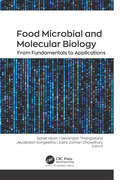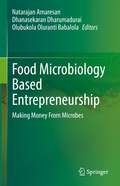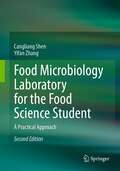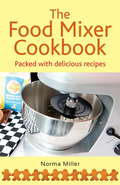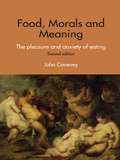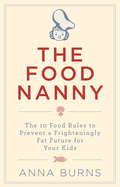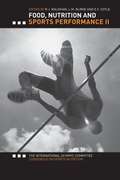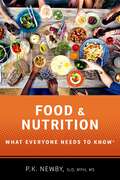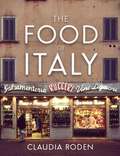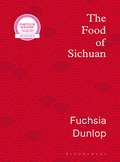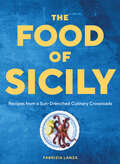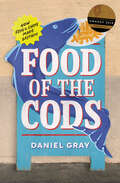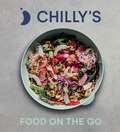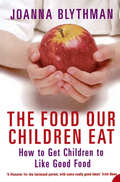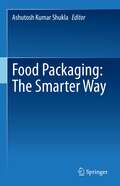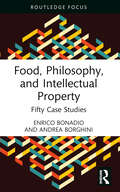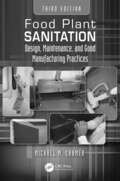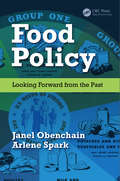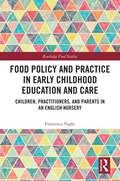- Table View
- List View
Food Microbial and Molecular Biology: From Fundamentals to Applications
by Saher Islam Devarajan Thangadurai Jeyabalan Sangeetha Zaira Zaman ChowdhuryThe ever-increasing globalization of the food industry demands new interventions and prevention technologies to improve the safety and quality of food. This multidisciplinary new book presents advanced systems for identifying, analyzing, tracking, and monitoring microbial contaminants in food.Key features:• Highlights emerging and re-emerging foodborne microorganisms and their virulence characteristics• Includes recent approaches for food quality assurance and risk management• Describes the practicality of molecular biology and microbial technologies for effectual control of foodborne infections• Presents a detailed overview of the utilization of recent molecular techniques in food microbiologyWith expert contributions from experienced academics involved in food microbiology and molecular biology research, this book offers indispensable guidance and a contemporary update of the latest developments in food microbial and molecular biology.
Food Microbial and Molecular Biology: From Fundamentals to Applications
by Saher Islam Devarajan Thangadurai Jeyabalan Sangeetha Zaira Zaman ChowdhuryThe ever-increasing globalization of the food industry demands new interventions and prevention technologies to improve the safety and quality of food. This multidisciplinary new book presents advanced systems for identifying, analyzing, tracking, and monitoring microbial contaminants in food.Key features:• Highlights emerging and re-emerging foodborne microorganisms and their virulence characteristics• Includes recent approaches for food quality assurance and risk management• Describes the practicality of molecular biology and microbial technologies for effectual control of foodborne infections• Presents a detailed overview of the utilization of recent molecular techniques in food microbiologyWith expert contributions from experienced academics involved in food microbiology and molecular biology research, this book offers indispensable guidance and a contemporary update of the latest developments in food microbial and molecular biology.
Food Microbiology Based Entrepreneurship: Making Money From Microbes
by Natarajan Amaresan Dhanasekaran Dharumadurai Olubukola Oluranti BabalolaThis book is first part of the 3 volume set focusing on basic and advanced methods for using microbiology as an entrepreneurial venture. This book deals with the concept of entrepreneurship skills for production, cost-benefit analysis and marketing of button, oyster, milky mushroom, Ganoderma sp, Single cell protein, Breads, Cheese, Yoghurt, Wine, Beer, Probiotics, Prebiotics fermented vegetables, and Fermented Fish etc. Chapters cover the applications of microorganisms in small and large scale production to achieve a sustainable output. This book provides essential knowledge and working business protocols from all related disciplines of food and dairy industry, probiotics industry, mushroom industry, beverage and baking industry, poultry industry, and aquaculture industry etc. This book is useful to graduate students, research scholars and postdoctoral fellows, and teachers who belong to different disciplines via botany, food microbiology, biotechnology, aquaculture microbiology and poultry microbiology. The other two volumes are focused on agriculture and industrial microbiology.
Food Microbiology Laboratory for the Food Science Student: A Practical Approach
by Cangliang Shen Yifan ZhangThis book is designed to give students an understanding of the role of microorganisms in food processing and preservation; the relation of microorganisms to food spoilage, foodborne illness, and intoxication; general food processing and quality control; the role of microorganisms in health promotion; and federal food processing regulations. The listed laboratory exercises are aimed to provide a hands-on-opportunity for the student to practice and observe the principles of food microbiology. Students will be able to familiarize themselves with the techniques used to research, regulate, prevent, and control the microorganisms in food and understand the function of beneficial microorganism during food manufacturing process. The second edition add 5 new chapters including “Chapter 10 -Thermal inactivation of Escherichia coli O157:H7 in mechanically tenderized beef steaks and color measurements”, “Chapter 11-Evaluate antimicrobial activity of chlorine water on apples and measurement of free chlorine concentrations”, “Chapter 12-Evaluate cross-contamination of Salmonella on tomatoes in wash water using most probable number (MPN) technique”, “Chapter 15-DNA extraction and purity determination of foodborne pathogens”, and “Chapter 16-Practice of multiplex PCR to identify bacteria in bacterial solutions”. It also includes new lab work flowcharts for Gram-staining and endospore-staining technology in Chapter 1, pour plating and spread plating in Chapter 3, Enterotube II in Chapter 9, and Kirby Beau test procedure in Chapter 20. It includes a new sample of syllabus with the hybrid teaching of both lecture and lab sections in one course, which will assist junior faculty/instructors to develop similar lecture and lab courses.
The Food Mixer Cookbook: Packed With Delicious Recipes
by Norma MillerHome-made food has so many attractions. With your food mixer to hand, cakes and pastries, pies and tarts, sweet and savoury fillings and lots more besides, are quick, easy and fun to make. Children will love joining in with weighing ingredients and decorating the finished product. A food mixer also means much more control over the choice and quality of ingredients.Discover how to exploit this handy kitchen aid to its full potential, using the versatility of the food mixer's three blades and their functions to whisk, whip, knead and mix.There is a mouthwatering and tempting collection of over 100 delicious recipes including sweet and savoury recipes: biscuits and cookies; scones and muffins, small cup cakes and tray bakes; large cakes and teabreads; puddings and desserts; as well as savoury pies, tarts, pastries and crumbles; breads and pasta. And there are also recipes for icings and spreads, fillings, toppings, and much more.
Food, Morals and Meaning: The Pleasure and Anxiety of Eating
by John CoveneyFollowing on from the success of the first edition, John Coveney traces our complex relationship with food and eating and our preoccupation with diet, self-discipline and food guilt. Using our current fascination with health and nutrition, he explores why our appetite for food pleasures makes us feel anxious. This up-to-date edition includes an examination of how our current obsession with body size, especially fatness, drives a national and international panic about the obesity ‘epidemic’. Focusing on how our food anxieties have stemmed from social, political and religious problems in Western history, Food, Morals and Meaning looks at: the ancient Greeks’ preoccupation with eating early Christianity and the conflict between the pleasures of the flesh and spirituality scientific developments in eighteenth and nineteenth century Europe and our current knowledge of food the social organization of food in the modern home, based on real interviews the obesity ‘epidemic’ and its association with moral degeneration. Based on the work of Michel Foucault, this fresh and updated edition explains how a rationalization food choice – so apparent in current programmes on nutrition and health – can be traced through a genealogy of historical social imperatives and moral panics. Food, Morals and Meaning is essential reading for those studying nutrition, public health, sociology of health and illness and sociology of the body.
Food, Morals and Meaning: The Pleasure and Anxiety of Eating
by John CoveneyFollowing on from the success of the first edition, John Coveney traces our complex relationship with food and eating and our preoccupation with diet, self-discipline and food guilt. Using our current fascination with health and nutrition, he explores why our appetite for food pleasures makes us feel anxious. This up-to-date edition includes an examination of how our current obsession with body size, especially fatness, drives a national and international panic about the obesity ‘epidemic’. Focusing on how our food anxieties have stemmed from social, political and religious problems in Western history, Food, Morals and Meaning looks at: the ancient Greeks’ preoccupation with eating early Christianity and the conflict between the pleasures of the flesh and spirituality scientific developments in eighteenth and nineteenth century Europe and our current knowledge of food the social organization of food in the modern home, based on real interviews the obesity ‘epidemic’ and its association with moral degeneration. Based on the work of Michel Foucault, this fresh and updated edition explains how a rationalization food choice – so apparent in current programmes on nutrition and health – can be traced through a genealogy of historical social imperatives and moral panics. Food, Morals and Meaning is essential reading for those studying nutrition, public health, sociology of health and illness and sociology of the body.
The Food Nanny: The 10 Food Rules to Prevent a Frighteningly Fat Future for Your Children
by Anna BurnsDo you find yourself constantly bombarded with requests for sweets, treats and snacks by your kids? Is the supermarket a battleground every time? Do your kids spend a lot more time indoors watching TV than you would have been allowed as a child? Would you love to see them eat more vegetables and make it through a movie without consuming the caloric allowance of a small elephant? If you want to do better for your kids, if you want to save them from a lifetime of yo-yo dieting, if you want them to be as Nature intended, The Food Nanny is here to help.
Food, Nutrition And Sports Performance II: The International Olympic Committee Consensus On Sports Nutrition (PDF)
by Ron Maughan L. M. Burke E. F. CoyleThis book summarizes the latest meeting of the world's leading researchers in sports nutrition, held at the IOC headquarters in Lausanne, Switzerland. The aim of the conference was to review the latest developments in the world of sport nutrition, to follow up on developments since the previous 1991 conference, and to draw up guidelines to help athletes and coaches optimise their performance by using nutrition to support training and maximise performance in competition. Subjects discussed in this cutting-edge collection include: * energy balance and body composition * the role of carbohydrates * the role of proteins and amino acids * athlete fluid and electrolyte requirements * the use of dietary supplements for optimum performance and immune function.
FOOD & NUTRITION WENK C: What Everyone Needs to Know® (What Everyone Needs To Know®)
by P.K. NewbyFrom gluten-free to all-Paleo, GMOs to grass-fed beef, our newsfeeds abound with nutrition advice. Whether sensational headlines from the latest study or anecdotes from celebrities and food bloggers, we're bombarded with "superfoods" and "best ever" diets promising to help us lose weight, fight disease, and live longer. At the same time, we live in an over-crowded food environment that makes it easy to eat, all the time. The result is an epidemic of chronic disease amidst a culture of nutrition confusion-and copious food choices that challenge everyday eaters just trying to get a healthy meal on the table. But the exhilarating truth is that scientists know an astounding amount about the power of food. A staggering 80% of chronic diseases are preventable through modifiable lifestyle changes, and diet is the single largest contributing factor. And we also know the secrets to eating sustainably to protect our planet. In Food & Nutrition, Harvard- and Columbia-trained nutrition scientist Dr. P.K. Newby examines 134 stand-alone questions addressing "need to know" topics, including how what we eat affects our health and environment, from farm to fork, and why, when it comes to diet, the whole is greater than the sum of its parts-and one size doesn't fit all. At the same time, Newby debunks popular myths and food folklore, encouraging readers to "learn, unlearn, and relearn" the fundamentals of nutrition at the heart of a health-giving diet. Her passion for all things food shines through it all, as does her love of the power of science, technology, and engineering to help create healthier diets for ourselves, and a more sustainable future for the planet we share.
The Food Of Italy
by Claudia RodenLike Elizabeth David, Claudia Roden can write about anything. Whether it's Middle Eastern, Spanish or Italian food, she is the cook to turn to. She is world renowned for her classic books like Arabesque and the Book of Jewish Food. These draw on her Egyptian Jewish roots so it's no wonder Middle Eastern chefs like Ottolenghi are among her biggest fans. But it is interesting to see that Russell Norman of Polpo cites Food of Italy as his favourite cookbook. Polpo is very cool, very modern, very Italian and yet still Claudia Roden's classic is his go-to cookbook. Food of Italy was first published 25 years ago next year. But the recipes are so fresh yet timeless they are hard to date. For this edition she has updated over 30% of the recipes to fit modern tastes with new inclusions like farro salad and burrata. The book is structured by region. So you get the glorious tomato and aubergine dishes of Sicily; the classically Roman dishes like salty meat and fried vegetables, and rich Tuscan stews and soups, and so on. With over 300 short recipes it is an incredible repertoire, and it is completely approachable for home cooks. This fully illustrated edition includes recipe photos as well as local Italy scenes. This is the first time it has had photos since it was originally published.
The Food of Sichuan
by Fuchsia Dunlop'No one explains the intricacies of Sichuan food like Fuchsia Dunlop. This book remains my bible for the subject' Jay RaynerA fully revised and updated edition of Fuchsia Dunlop's landmark book on Sichuan cookery.Almost twenty years after the publication of Sichuan Cookery, voted by the OFM as one of the greatest cookbooks of all time, Fuchsia Dunlop revisits the region where her own culinary journey began, adding more than 50 new recipes to the original repertoire and accompanying them with her incomparable knowledge of the dazzling tastes, textures and sensations of Sichuanese cookery.At home, guided by Fuchsia's clear instructions, you will be able to recreate Sichuanese classics such as Mapo tofu, Twice-cooked pork and Gong Bao chicken, or try your hand at a traditional spread of cold dishes comprising Bang bang chicken, Numbing-and-hot dried beef, Spiced cucumber salad and Green beans in ginger sauce. With spellbinding writing on the culinary and cultural history of Sichuan and accompanied by gorgeous travel and food photography, The Food of Sichuan is a captivating insight into one of the world's greatest cuisines.'This book offers an unmissable opportunity to utilise the wok and cleaver, brave the fiery Mapo tofu and expand your technique with pot-stickers and steamed buns' Yotam Ottolenghi
The Food of Sicily: Recipes from a Sun-Drenched Culinary Crossroads
by Fabrizia LanzaIn this all-new cookbook from Fabrizia Lanza, one of the world&’s greatest food cultures is distilled in 75 recipes for the home cook, plus a loving tribute to its ingredients, passions, influences, and history Tucked away on an estate in the countryside south of Palermo is the Anna Tasca Lanza Cooking School, a unique center dedicated to preserving and sharing the great food culture of Sicily. The spirit of the school, now run by Fabrizia Lanza, the founder&’s daughter and scion of a renowned family of winemakers that goes back generations, is what makes Lanza&’s The Food of Sicily such a singular cookbook—not just a collection of recipes and techniques, but a vibrant and beautifully photographed profile of the land, the people, the history, and so much more. On every page, in every recipe and note, the author captures the distinct taste of Sicily. How the simplest antipasti, brightly seasoned with nothing but lemon or vinegar, open the appetite—like a classic Octopus Salad or dish of Sautéed Black Olives. The little fried somethings—like an arancine or panelle—are easy, welcome, and nourishing. The Fresh Cavatelli, Pasta with Eggplant and Tomatoes, Bucatini with Sardines and Wild Fennel, and the eye-opening Anelletti Timballo explain why Sicilians are the biggest pasta eaters in the world. Festive meat dishes—such as Lamb-Stuffed Pastry, an Easter staple, or Grilled Sausage with Bay Leaves and Onions—are festive because the moment it&’s holiday time, Sicilians everywhere head outside and fire up their grills. And for a people known for their passion for sweets, some famous Sicilian treats—Watermelon Pudding, Lemon Granita, Rolled Fig Cookies, and the pinnacle of desserts, the elaborate Sicilian Cake with Ricotta Cream and Marzipan. Along the way, the author delves into everything from cheese, couscous, and olives to Amaro and the importance of bitterness. Visitors to Sicily often sense it to be a place unlike anywhere else—lost in time and a little bit secretive. The Food of Sicily opens a bright window on it, celebrating this wonderful food culture while honoring everything that makes it special.
Food of the Cods: How Fish and Chips Made Britain
by null Daniel GrayShortlisted for Debut Food Book of the Year at the Fortnum and Mason Food and Drink Awards 2024 ‘A lyrical, amiable and educational celebration of what may be our greatest achievement: the chippy.’ Stuart Maconie Step inside and unwrap this deliciously entertaining look at Britain’s national dish. There is a corner of every town and city in Britain where the air is tangy with vinegar and the scent of frying. Following the irresistible lure, Daniel Gray ponders the magic of chippies and the delights they have sprinkled among us for the last 150 years as he investigates the social – and sociable – history of fish and chips. Travelling to chippies from Dundee to Devon via South Shields, Oldham, Bradford, Bethnal Green, the Rhondda Valley and more – Daniel Gray explores our fish-and-chip nation to show how chippies have helped emancipate women, promote equality for immigrants and shape local and national identity. Whether you were raised eating scraps of Wolverhampton’s orange chips, London’s ‘wallies’ or Hull’s chip spice – even if you think you know whether tea, Vimto or dandelion and burdock is the best accompaniment – this mouth-watering book is as much about who we are as what we eat.
Food on the Go: The Chilly’s Cookbook
by Chilly'sIn Food on the Go you'll find healthy and tasty meals to suit all tastes, from sweet items such as Chia Seed Chocolate Powerpots and an On-The-Go Smoothie to fulfilling dishes including Easy Ramen, Lamb Curry Bao Buns, Bang Bang Tofu Salad and a Salmon Poke Bowl. Chapters include Breakfast, Soups & Hotpots, Wraps & Sandwiches, Salads, Snacks & Treats and Drinks, so Food on the Go will slot seamlessly into your lifestyle at any time of day.From the pioneers of reusables, these 75 easy and delicious recipes are designed to fit perfectly into your busy life - and your Chilly's products.Created to elevate your eating and drinking experience, Food on the Go is packed with convenient and exciting inspiration for every meal. Every recipe has been formulated to work dynamically with your Chilly's reusables, which will keep your food hot or cold throughout the day.
The Food Our Children Eat: How To Get Children To Like Good Food
by Joanna BlythmanA majority of British children mainly eat processed and junk food. Award-winning food writer Joanna Blythman takes a controversial look at this curious phenomenon and offers parents practical tips on how to improve their children’s diet.
Food Oxidants and Antioxidants: Chemical, Biological, and Functional Properties
by Grzegorz BartoszFood antioxidants are of primary importance for the preservation of food quality during processing and storage. However, the status of food depends on a balance of antioxidants and prooxidants occurring in food. Food Oxidants and Antioxidants: Chemical, Biological, and Functional Properties provides a single-volume reference on the effects of natur
Food Packaging: The Smarter Way
by Ashutosh Kumar ShuklaThis book reviews the science and technology of food packaging and covers the potential innovations in the food packaging sector. At the same time, it highlights the issues and prospects for linking the laboratory research to the market. In addition to typical packaging requirements such as food quality, shelf life, protection, communication, and marketing, the book emphasizes the need for novel packaging materials, including biodegradable packaging for a variety of food products. A wide range of food products has been kept in focus and includes animal-based food products such as dairy products and sea foods. The book presents the next level of packaging solutions i.e., smart packaging with the applications of potential tools such as intelligent and active packaging, and includes the latest research on emerging digital technologies for packaging development, assessment, and acceptability. It further highlights the strategies including blends, reinforcing agents, cold plasma, UV light applications, chemical, and enzymatic methods and explores the new opportunities leading to improvement in the packaging performance. Smart freshness indicator applications, including gas and time-temperature indicators for quality and safety of packaged products, have been covered in detail. The book also includes the functional characteristics of edible films and coatings, including their bioactive characteristics. Finally the book presents the rules and regulation related to packaging.
Food, Philosophy, and Intellectual Property: Fifty Case Studies
by Enrico Bonadio Andrea BorghiniThis is a book about food, philosophy, and intellectual property rights.Taken separately, these are three well-known subjects, but it is uncommon to consider them together. The book comprises 50 case studies, organized around eight themes: images; genericity and descriptiveness; language traps; procedures; menus, recipes, and creativity; boundaries; biotech; and empowerment. The introductory chapter frames the selection of cases and encourages readers to look beyond them, envisaging new lenses to look at food vis-à-vis intellectual property. The terrain encompassed is wide-ranging and reaches out to fine-grained aspects of food products, recipes, and cooking. Conceived for a wide scope of readers, the volume ultimately interrogates the links between food and cultural identity, bringing to the fore the ethical, political, and aesthetic worth of culinary arts and gastronomic experiences.This accessible book will be of value to scholars, students, practitioners, and others with interests in the areas of intellectual property, food law, and food studies.
Food, Philosophy, and Intellectual Property: Fifty Case Studies
by Enrico Bonadio Andrea BorghiniThis is a book about food, philosophy, and intellectual property rights.Taken separately, these are three well-known subjects, but it is uncommon to consider them together. The book comprises 50 case studies, organized around eight themes: images; genericity and descriptiveness; language traps; procedures; menus, recipes, and creativity; boundaries; biotech; and empowerment. The introductory chapter frames the selection of cases and encourages readers to look beyond them, envisaging new lenses to look at food vis-à-vis intellectual property. The terrain encompassed is wide-ranging and reaches out to fine-grained aspects of food products, recipes, and cooking. Conceived for a wide scope of readers, the volume ultimately interrogates the links between food and cultural identity, bringing to the fore the ethical, political, and aesthetic worth of culinary arts and gastronomic experiences.This accessible book will be of value to scholars, students, practitioners, and others with interests in the areas of intellectual property, food law, and food studies.
Food Plant Sanitation: Design, Maintenance, and Good Manufacturing Practices
by Michael M. CramerFood safety and quality are primary concerns in the food manufacturing industry. Written by an author with more than 40 years’ experience in the food industry, Food Plant Sanitation: Design, Maintenance, and Good Manufacturing Practices, Third Edition provides completely updated practical advice on all aspects of food plant sanitation and sanitation-related food safety issues. It offers readers the tools to establish a food safety system to help control microbiological, physical, and chemical hazards. Understanding that sanitation is integral to food safety is the foundation for an effective food safety system. Features of this new edition include new photographs, tables, and up-to-date material that better reflect current guidance on food plant sanitation, including additional information on the implementation of FSMA. The chapters address testing for and control of microorganisms in food manufacturing, including recent challenges in the industry due to pathogens such as Listeria monocytogenes. They also offer discussions on biofilms, regulatory requirements from the European Union, allergens, sanitary facility design, and describe proven best practices for sanitation as well as current sanitary requirements and regulatory changes from the FDA and USDA. In addition, the author presents methods for verifying sanitation, and provides greater differentiation of verification versus validation. The final chapters identify good manufacturing practices for employees and present a comprehensive pest management plan, including control measures and chemical interventions. The book concludes with strategies for preventing chemical and physical food safety hazards. This reference provides a practical perspective for implementing food plant sanitation and safety processes. The author has included, wherever possible, examples of procedures, forms, and documents to help novice food safety and quality professionals develop effective food safety systems.
Food Plant Sanitation: Design, Maintenance, and Good Manufacturing Practices
by Michael M. CramerFood safety and quality are primary concerns in the food manufacturing industry. Written by an author with more than 40 years’ experience in the food industry, Food Plant Sanitation: Design, Maintenance, and Good Manufacturing Practices, Third Edition provides completely updated practical advice on all aspects of food plant sanitation and sanitation-related food safety issues. It offers readers the tools to establish a food safety system to help control microbiological, physical, and chemical hazards. Understanding that sanitation is integral to food safety is the foundation for an effective food safety system. Features of this new edition include new photographs, tables, and up-to-date material that better reflect current guidance on food plant sanitation, including additional information on the implementation of FSMA. The chapters address testing for and control of microorganisms in food manufacturing, including recent challenges in the industry due to pathogens such as Listeria monocytogenes. They also offer discussions on biofilms, regulatory requirements from the European Union, allergens, sanitary facility design, and describe proven best practices for sanitation as well as current sanitary requirements and regulatory changes from the FDA and USDA. In addition, the author presents methods for verifying sanitation, and provides greater differentiation of verification versus validation. The final chapters identify good manufacturing practices for employees and present a comprehensive pest management plan, including control measures and chemical interventions. The book concludes with strategies for preventing chemical and physical food safety hazards. This reference provides a practical perspective for implementing food plant sanitation and safety processes. The author has included, wherever possible, examples of procedures, forms, and documents to help novice food safety and quality professionals develop effective food safety systems.
Food Policy: Looking Forward from the Past
by Janel Obenchain Arlene SparkAccess to safe, adequate, and nutritionally balanced food is a cornerstone of public health. Food Policy: Looking Forward from the Past examines the influences of grassroots movements, the government, and industry on the US food systems. The authors explore the intersection of food and nutrition and how policy influences this overlap. They illumina
Food Policy and Practice in Early Childhood Education and Care: Children, Practitioners, and Parents in an English Nursery (Routledge Food Studies)
by Francesca VaghiThis book is about food and feeding in early childhood education and care, offering an exploration of the intersection of children’s food, education, family intervention, and public health policies. The notion of ‘good’ food for children is often communicated as a matter of common sense by policymakers and public health authorities; yet the social, material, and practical aspects of feeding children are far from straightforward. Drawing on a detailed ethnographic study conducted in a London nursery and children’s centre, this book provides a close examination of the practices of childcare practitioners, children, and parents, asking how the universalism of policy and bureaucracy fits with the particularism of feeding and eating in the early years. Looking at the unintended consequences that emerged in the field, such as contradictory public health messaging and arbitrary policy interventions, the book reveals the harmful assumptions about disadvantaged groups that are perpetuated in policy discourse, and challenges the constructs of individual choice and responsibility as main determinants of health. Children’s food practices at the nursery are examined to explore the notion that, whilst for adults it is what children eat that often matters most, to children it is how they eat that is more important. This book contributes to a growing body of literature evidencing how children’s food is a contested domain, in which power relations are continuously negotiated. This raises questions not only on how children can be included in policy beyond a tokenistic involvement but also on what children’s well-being might mean beyond the biomedical sphere. The book will particularly appeal to students and scholars in food and health, food policy, childhood studies, and medical anthropology. Policymakers and non-governmental bodies working in the domains of children’s food and early years policies will also find this book of interest.
Food Policy and Practice in Early Childhood Education and Care: Children, Practitioners, and Parents in an English Nursery (Routledge Food Studies)
by Francesca VaghiThis book is about food and feeding in early childhood education and care, offering an exploration of the intersection of children’s food, education, family intervention, and public health policies. The notion of ‘good’ food for children is often communicated as a matter of common sense by policymakers and public health authorities; yet the social, material, and practical aspects of feeding children are far from straightforward. Drawing on a detailed ethnographic study conducted in a London nursery and children’s centre, this book provides a close examination of the practices of childcare practitioners, children, and parents, asking how the universalism of policy and bureaucracy fits with the particularism of feeding and eating in the early years. Looking at the unintended consequences that emerged in the field, such as contradictory public health messaging and arbitrary policy interventions, the book reveals the harmful assumptions about disadvantaged groups that are perpetuated in policy discourse, and challenges the constructs of individual choice and responsibility as main determinants of health. Children’s food practices at the nursery are examined to explore the notion that, whilst for adults it is what children eat that often matters most, to children it is how they eat that is more important. This book contributes to a growing body of literature evidencing how children’s food is a contested domain, in which power relations are continuously negotiated. This raises questions not only on how children can be included in policy beyond a tokenistic involvement but also on what children’s well-being might mean beyond the biomedical sphere. The book will particularly appeal to students and scholars in food and health, food policy, childhood studies, and medical anthropology. Policymakers and non-governmental bodies working in the domains of children’s food and early years policies will also find this book of interest.
